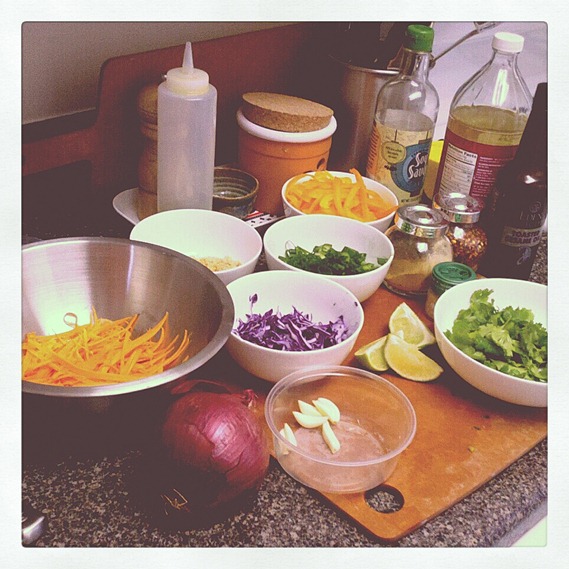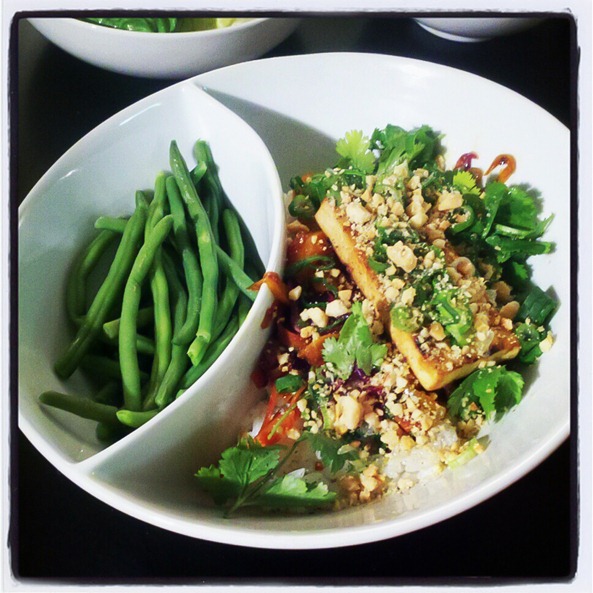Inspiration in the Kitchen
One of the questions that I’m almost always asked, since starting culinary school, is what types of meals I make at home. Am I suddenly busting out three-course meals for dinner?
In fact, Connor is asked by his med school friends, on an almost daily basis, whether I make him gourmet lunchbox meals every night (HA!). Or they just casually remark on the fact that we must eat “so well” due to my new education. While I do think we eat well—I still find all these comments highly amusing. Mostly, because they are incredibly far from the truth.
I still struggle to come up with new (realistic) ideas for weeknight dinners, enjoy eating a Trader Joe’s Tikka Masala frozen meal every now and then, and crave Chipotle burrito bowls far more than I would like to admit. I believe most of us all have a built-up mental rolodex of ideas, whether inspired by blogs, restaurants, food magazines, or cookbooks, but real life tends to get in the way. We look in the fridge to realize we have nothing to work with, don’t feel like going grocery shopping for the 5th time in a week, or just don’t have the energy or time.
During these instances, I almost always turn to flavor profiles for inspiration. As a result of cooking very classic French, European dishes every day, I tend to crave the exact opposite every night: Mexican, Italian, Asian, or Indian. Helpful, no?
However, despite how remarkably different these types of cuisines are to what I’m making on a daily basis, you would be surprised that despite their massive differences, every successful dish or pairing boils down to the the same, basic principle: Balance.
Salt. Bitter. Sour/Acid. Sweet
If anyone asked me what was the biggest lesson I have learned since starting culinary school, it would be this. Balancing flavors and seasoning food properly.
This can literally mean the difference between a dish that is just “ok” and one that is great. Such a simple concept in theory, but probably one the most difficult to execute.
Obviously, this is something I’m still learning how to do properly (and most likely will be, for the rest of my life!), but something that has also been a source of inspiration on those nights when I struggle to figure out what what the heck to make for dinner.
For example, this random Asian-rice bowl dinner idea I came up with the other day…
Grilled Tofu (simply marinated with some soy sauce, garlic, ginger, sesame oil, spring onions) on top of sushi rice with stir-fried carrots, red peppers, red cabbage, & red onion, topped with sesame seeds, red pepper flakes, lots of fresh cilantro, raw spring onions, and toasted, crushed peanuts.
Last, but not least, a squeeze of lime juice—which really took it from being “good” to “really good”.
I was pleasantly surprised by how delicious this meal ended up being (especially given how randomly I threw it all together), but in the end, it really came down to the balance of flavors.
Salt = soy sauce
Sweetness = Sauteed red onions, bell peppers, carrots, & peanuts
Bitter = the caramelized onions, grilled tofu
Sour/Acid = lime juice
Spicy/Heat: Red Pepper Flakes, cilantro, fresh ginger
Texture: Crunchy Peanuts
If I had left any of the above out of the final dish, it probably wouldn’t have been nearly as satisfying.
Therefore, my biggest advice is, the next time you find yourself in the kitchen struggling to figure out your next meal (or even just thinking about how to improve any dish you’ve made in the past), start with these basics. It is still something I have to remind myself to do on a regular basis!
I can’t tell you how much it can help simplify the cooking process! It also has the added bonus of making you that much more creative in the kitchen. If you’re looking for even more inspiration, I highly recommend checking out the book, The Flavor Bible, by Karen Page & Andrew Dornenburg. It is one of my favorite, go-to books!
Happy Cooking!




4 Comments on “Inspiration in the Kitchen”
Leann — Tough question!! It definitely depends on what you want to be able to do….some of the equipment that I use every day at culinary school, such as chinois strainers, are not necessarily things I would buy to use at home.
I do think that food processors are one of the best kitchen appliances to have! There are many things you cannot make at home without one of these, for example pestos, etc. They can also be used to do a lot more, like make dough, pasta, etc. I actually only have a mini-food processor, but I use it a lot, especially for grating things like parmesan. It saves a lot of time. Also, if you are baking a lot, a stand mixer is a must. Plus, it allows you to make a lot more complex things and have your hands free!
Other than that, I would say one of the most useful things you can have is a great chef's knife, good sturdy cutting board, straight-sided saute pan (for sauces, deglazing, etc), and tongs.
What tools do you recommend that every home cook should have? Can you replicate dishes at home if you don't have any fancy tools or equipment?
Hi there, hopefully I can go to culinary school in the long run.. For the moment, I am just working with traditional food. I have been watching a few programs as well such as Top Chef, Chopped and so on.
I think before balancing, you need to know your ingredient very well, this gives you an edge and helps you play with the flavours and hence balance it
I am a vegetarian (no egg, meat, or fish), so I am going to do my best to try your recipes.
🙂
Laura this is a great post! Love the flavor profile tip. Sounds like my favorite show – Chopped! Hope things are going great for you. Thanks again.